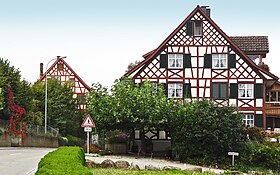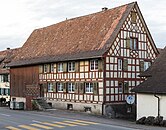Triboltingen
| Triboltingen | ||
|---|---|---|
| State : |
|
|
| Canton : |
|
|
| District : | Kreuzlingen | |
| Political community : | Ermatingen | |
| Postal code : | 8273 | |
| Coordinates : | 725 677 / 280380 | |
| Height : | 416 m above sea level M. | |
| Area : | 2.54 km² | |
| Residents: | 442 (December 31, 2018) | |
| Population density : | 174 inhabitants per km² | |
|
Eastern entrance to the village |
||
| map | ||
|
|
||
Triboltingen is a former municipality and a village in the political municipality of Ermatingen in the Kreuzlingen district of the canton of Thurgau in Switzerland .
Triboltingen was part of the municipality of Ermatingen from 1803 to 1974 and from 1812 it was its own local community. In 1975 Triboltingen became part of the unified municipality of Ermatingen.
geography
The street village lies at the foot of the Seerücken and the Untersee between Tägerwilen and Ermatingen. Triboltingen is from the main road Schaffhausen-Kreutlingen opened and since 1998 a stop on the parallel leading to sea line .
history

A discovered fire ditch from the first century indicates an early Roman settlement. The village itself was founded by the Alemanni . Together with Salenstein , Fruthwilen , Mannenbach and Ermatingen, Triboltingen formed a brand cooperative (forest, pasture). Around 950, Duke Hermann von Schwaben donated the village to the Reichenau monastery . According to a chronicle, during the famine of 1146, the Triboltingers fled with their belongings to the nearby Petershausen monastery in Constance . The village was first mentioned as a tribolting in a document. In the Middle Ages , Reichenau Monastery was the most important landlord and court lord in Triboltingen. From 1540 to 1798 the village was under the jurisdiction of the Prince Diocese of Constance . The battle in Schwaderloh took place east of Triboltingen in 1499 .
The majority Reformed Triboltingen always belonged to the parish of Ermatingen. After the Reformation , which took place around 1528, hardly any services were held in the St. Niklaus chapel, which dates back to the 13th century .
In the 18th century, Triboltingen owned a parish hall, the Zwingwald and vineyards, in addition to other municipal goods. In the 19th century, viticulture formed the basis of prosperity. Around 1900 embroidery was also practiced. After 1950, the closure of farms began. Converted to residential houses, they shaped the townscape with the single-family houses that were built at the beginning of the 21st century.
population
| year | 1850 | 1900 | 1950 | 1990 | 2000 | 2010 | 2018 |
| Local parish | 345 | 314 | 284 | 302 | |||
| Locality | 291 | 377 | 442 | ||||
| source | |||||||

- Population development data from the 1850 to 1970 censuses
Of the total of 442 inhabitants in the village of Triboltingen in 2018, 114 or 25.8% were foreign nationals. 196 (44.3%) were Protestant Reformed and 115 (26.0%) were Roman Catholic.
Attractions
The numerous half-timbered buildings date from the 17th to the early 19th century. The village of Triboltingen is listed in the inventory of places worthy of protection in Switzerland , the Paritätische Kapelle St. Nikolaus and the residential house Zur Post / Haus Schwarz are listed in the list of cultural assets in Ermatingen .
St. Niklaus Chapel
The chapel was probably built in the 13th century, from this time high arched windows are still preserved; the choir was added around 1500. An outstanding feature is the roof turret , built in 1602 , with a sweeping pointed helmet . The clockwork was made by Andreas Liechti from Winterthur . Inside, the remains of medieval wall paintings can be seen in three layers of paint. On the north wall of the nave there are red chalk drawings and pilgrim inscriptions from the late 15th century. After the Reformation the chapel was no longer used for church services. From 1850 it was used as a syringe house and even as a powder magazine during World War II. In 1957 it was renovated by the homeland security. Today, services are occasionally held in the chapel and it is also used for small concerts.
photos
literature
- Albert Knoepfli: The Triboltingen Chapel (Thurgau). In: Our art monuments. 8 (1957). Pp. 77-78.
- Arnold Bosshard, Peter Funk, Alfons Raimann: Ermatingen and Triboltingen TG. Bern 1988.
- Regine Abegg, Peter Erni, Alfons Raimann: The art monuments of the canton of Thurgau, Volume VIII: Around Kreuzlingen. Edited by the Society for Swiss Art History GSK. Bern 2014 (Art Monuments of Switzerland, Volume 125). ISBN 978-3-03797-116-1 . Pp. 143-173.
Web links
Individual evidence
- ↑ Swiss land use statistics. Completed on July 1, 1912. Published by the Federal Statistical Bureau. ( Memento from April 12, 2016 in the Internet Archive )
- ↑ a b c d Localities and their resident population. Edition 2019 . On the website of the Statistical Office of the Canton of Thurgau (Excel table; 0.1 MB), accessed on April 28, 2020.
-
↑ a b c d
Erich Trösch: Triboltingen. In: Historical Lexicon of Switzerland .
These sections are largely based on the entry in the Historical Lexicon of Switzerland (HLS), which, according to the HLS's usage information, is under the Creative Commons license - Attribution - Share under the same conditions 4.0 International (CC BY-SA 4.0). - ↑ Locations and Settlements Directory. Canton of Thurgau, 2005 edition . On the website of the Statistical Office of the Canton of Thurgau (PDF; 1.7 MB), accessed on April 28, 2020.
- ↑ Locations and Settlements Directory. Canton of Thurgau, 2012 edition. On the website of the Statistical Office of the Canton of Thurgau (PDF; 3.4 MB), accessed on May 11, 2020.
- ↑ Swiss Statistical Sources, Volume 511, Federal Population Census 1970, Volume 3.20, Canton Thurgau. Federal Statistical Office, Bern 1974 ( Memento from April 1, 2016 in the Internet Archive ), p. 139
Remarks
- ↑ with outside courtyards








